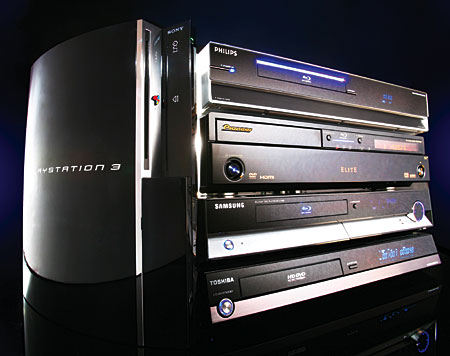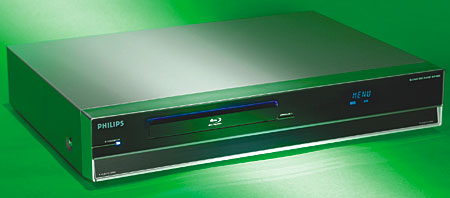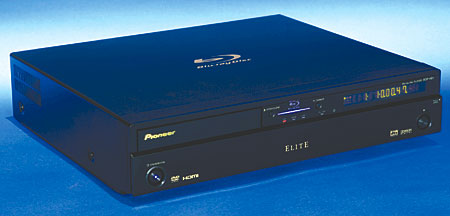Blu-ray Players Arrive
After a rocky start with the flawed-out-of-the-box Samsung BD-P1000 player, Blu-ray finally hit the stores for real at the turn of the year with several new players. These range from the top-of-the-line Pioneer BDP-HD1 ($1,500), to Philips' the more sedate BDP9000 ($1,000), to the Sony PlayStation 3 ($499 or $599).

To truly face these products off, there is only one way to do it. This requires an HDMI switcher, and the aptly named Gefen 4x1 HDMI Switcher is just what we need for this job. We also need a 1080p display, and the Sharp XV-Z20000 projector I reviewed for the March issue is also perfect. But, I didn't assume that this was the only way to see the image, so I also used a Pioneer PRO-FHD1 50-inch 1080p plasma (reviewed online).
To add to the mix, I also threw in the $999 Samsung Blu-ray player (in both its original and updated flavors), the original Toshiba HD DVD player—the $800 HD-XA1—as well as the new $500 HD-A2 (see sidebars). I picked one of the best discs available (Corpse Bride) and bought copious copies so that I could play the same scene on each player at the same time.
Philips BDP9000
Although the menus are different, the Philips is essentially the Samsung BD-P1000. The case is different—it's more staid than its brother, the Samsung. Depending on your opinion of the Samsung, this could be good or bad. The remote is certainly better, although silver on silver instead of black on black is just a baby step in improvement. Unlike the Samsung remote, it doesn't have any glowing buttons. Neither one is backlit. The player didn't sense the fact that it was hooked up to a 1080p display, but the resolution was selectable in the menus. Said menus are a lot friendlier and more pleasant than the Samsung's, which have a menu aesthetic familiar to anyone who owns a Samsung TV from the past few years.

 Make sure you go through the menus thoroughly; there are several options that default to "on" that you may not want (like Dynamic Range Compression). Its picture quality is similar to the others', which is to say it looks great with the right content. There doesn't seem to be any extraneous noise in the image nor the apparent softness of the Samsung before its update (see sidebar).
Make sure you go through the menus thoroughly; there are several options that default to "on" that you may not want (like Dynamic Range Compression). Its picture quality is similar to the others', which is to say it looks great with the right content. There doesn't seem to be any extraneous noise in the image nor the apparent softness of the Samsung before its update (see sidebar).
Like all of these standalone Blu-ray players, the HDMI isn't 1.3, so you won't be able to get the native version of Dolby Digital Plus, Dolby TrueHD, or DTS-HD via HDMI. What should surprise you is that no player or receiver currently does anything with these formats (other than convert the Dolby Digital Plus down to Dolby Digital). The formats can still be on the disc (but they typically aren't). Instead—and, again, like the other players here—the BDP9000 can either out-put the uncompressed linear PCM track over HDMI or output it as analog. Some receivers and pre/pros can handle that type of digital info.
Upconverted standard-definition DVDs go up to 1080p over HDMI, but the player doesn't upconvert via component. Its scaling performance is similar to the Samsung's. It's very noisy and artifacty. As far as regular DVD playback is concerned, I wouldn't recommend that you ditch your scaling DVD player just yet. But you do get 1080i over component with Blu-ray discs.
Pioneer BDP-HD1
The Pioneer is the only one of this group that looks its price. The PS3 looks better than its $500/$600, and the Philips and the Samsung look more like gussied-up DVD players. Then again, it better look like its price, seeing as it's $500 more expensive than the Philips and Samsung players and three times the price of the cheaper version of the PS3. What you get for your extra money is the only player here that can output the native 1080p/24 signal. There is only one other Blu-ray player on the market that can do this seemingly simple feat (the incredibly similar but allegedly different Sony BDP-S1). You also get Pioneer's Home Media Gallery, which streams content such as pictures or videos from PCs (but not Macs) on your home network via an Ethernet port on the back so you can see it on your TV. What you don't get is the ability to play CDs—at all. Personally, I'd like to see a version of this player without the Home Media Gallery but that still outputs 1080p/24.

 The BDP-HD1 takes the longest to go from off to playing a disc, well over 90 seconds. It's like a page out of the HD DVD handbook. But, also like an HD DVD player, it outputs a pristine image. For better or worse, you'll get everything that's on the disc.
The BDP-HD1 takes the longest to go from off to playing a disc, well over 90 seconds. It's like a page out of the HD DVD handbook. But, also like an HD DVD player, it outputs a pristine image. For better or worse, you'll get everything that's on the disc.
Like the other standalone players here, it can't output Dolby Digital Plus, Dolby TrueHD, or DTS-HD in their digital forms, but it can output the LPCM as 7.1 over HDMI or analog 5.1.
The remote is basic and not fitting for something of this price. Despite its faults, at least Toshiba's HD-XA1's flashy remote looked like something that would come with a $1,000 product.
The BDP-HD1 is a little noisy when it upconverts standard DVDs to 1080p over HDMI, but the amount of detail it pulls out of the DVD is quite good. It will not upconvert over component, and (oddly), if the HDMI is set for 1080p, you get 480i over component for DVD. If it's set for 1080i over HDMI, you get 480p. Like all the players, Blu-ray maxes out at 1080i over component.
When it comes down to it, the ability to play back 1080p/24 makes this the pick of the bunch. But, at $1,500 (and considering that few TVs accept that frame rate), it's less of a victory and really a "more equal among equals" situation.
























































